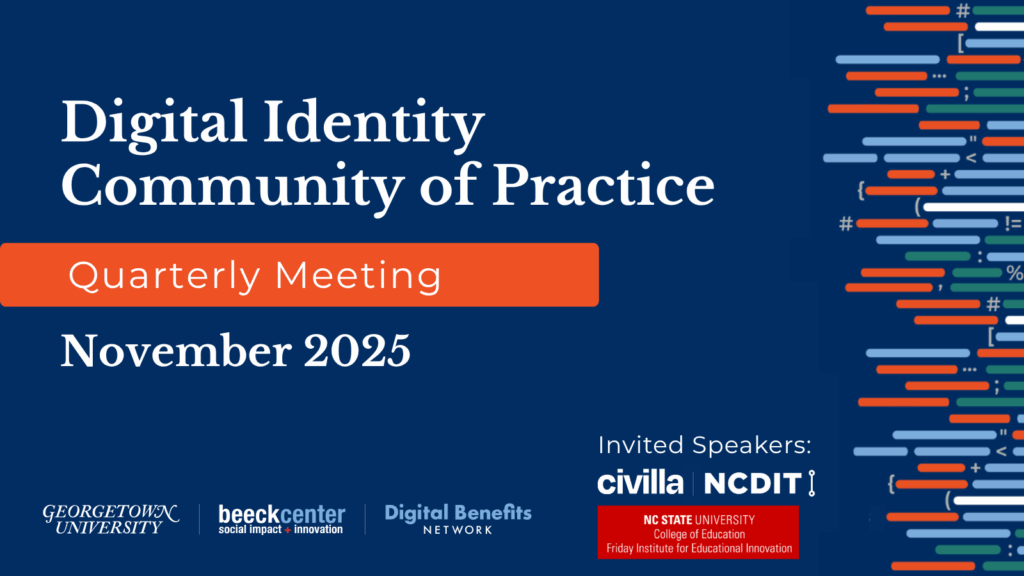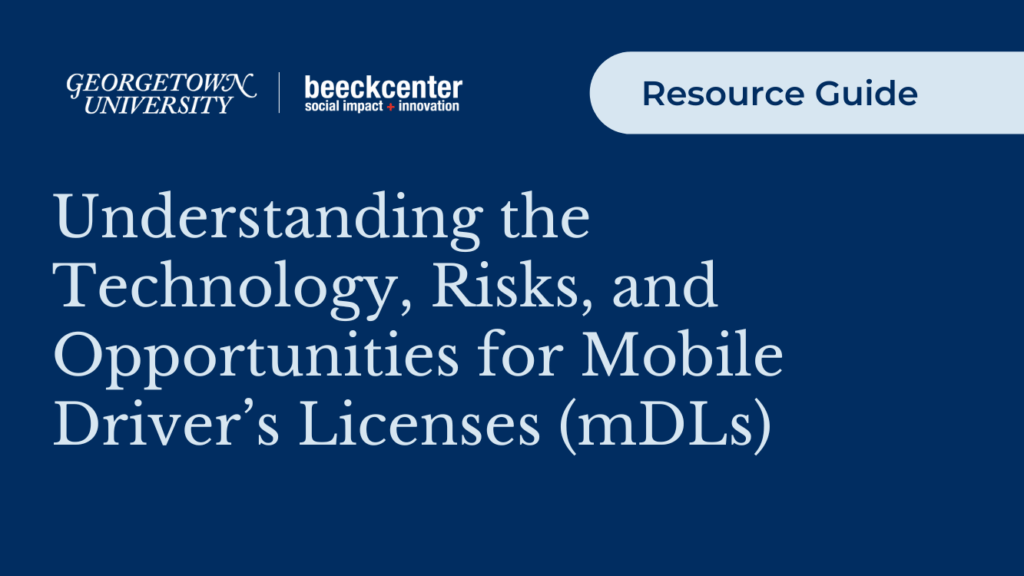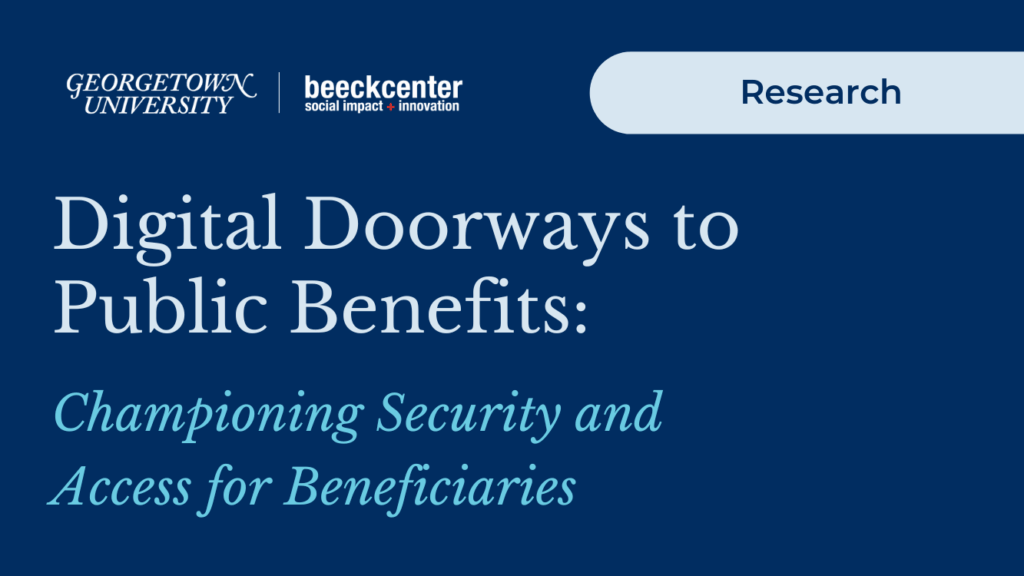Digital Authentication and Identity Proofing in Child Care Assistance Program (CCAP) Applications
On May 19, 2023, the Digital Benefits Network published a new, open dataset documenting authentication and identity proofing requirements across online SNAP, WIC, TANF, Medicaid, child care (CCAP) applications, and unemployment insurance applications. This page includes data and observations about authentication and identity proofing steps specifically for online applications that include child care applications.

On this page, we share data and observations about authentication and identity proofing steps for online child care assistance program (CCAP) applications. Because some states combine or integrate applications for multiple programs, this page includes data collected from standalone CCAP applications and integrated applications. For entries that include combined or integrated applications, our data demonstrates a claimant’s experiences if they are applying for all available benefits such as Child Care, Supplemental Nutrition Assistance Program (SNAP), Temporary Assistance for Needy Families program (TANF), and MAGI Medicaid together. We took this approach to data collection for practicality and also to document the most comprehensive experience possible for each application flow.
The dataset and details below demonstrate our current understanding of online authentication and identity proofing requirements and practices for this benefit program. As we continue to gather feedback and update the datasets, these numbers may change. These points should be viewed as general observations to help users make sense of this dataset more quickly. You can also view the Digital Benefits Network’s data on authentication and identity proofing practices across core benefits programs on the Digital Government Hub.
High-level Findings
Integrated Applications
Just over a third of applications for Child Care assistance were child-care specific, meaning the applications did not include other benefits.
- 13 of the Child Care assistance applications (38%) were child care-specific.
Login and Registration Requirements
Most applications that include Child Care assistance require users to create an account to apply.
- Most applications that include Child Care assistance 27 out of 34 (79%) require users to have or create an account before they can start the application. Another four applications make account creation optional at the start.
- Of the 31 Child Care assistance applications that use an account registration feature, 17 require email addresses during account setup.
- At least 25 sign in processes for applications that include Child Care assistance use additional authentication measures. These most often included security questions, email validation links and authentication codes sent via email.
This map shows authentication requirements in online applications that include Child Care assistance across states. The color-coding on this map details whether applicants are required to sign-in to start an application. When you hover over an individual state on the map, you can also see whether the application’s account creation process incorporates additional authentication security measures, whether an email address is required to create an account if applicable, what type of login is used such as state single sign-on (SSO), and what benefits programs are included on the application.
Identity Proofing Requirements
Applications that include Child Care assistance rarely require or prompt users to take active identity proofing steps to apply online.
- Only one application that includes Child Care assistance (Oregon’s ONE application) requires identity proofing using knowledge-based verification (KBV) provided by Experian, before a user can initiate an application.
- Five other applications that include Child Care assistance including Tennessee’s child care-specific application prompt optional identity proofing, also using KBV. Four of these applications prompt identity proofing before a user begins an application.
This map shows active identity proofing requirements in online applications that include Child Care assistance across states. The color-coding on this map details whether applicants are required to take active steps to prove their identities as part of an online application process. When you mouse over an individual state on the map, you can also see what identity proofing methods are being used if applicable or known, when during the application process identity proofing is used, and what benefits programs are included on the application.
Personally Identifiable Information (PII) Requested
Some Child Care assistance applications make it optional to provide a Social Security number (SSN) and many others make it possible to submit online without disclosing SSN.
- Based on program instructions from the Administration for Children and Families, first issued in 2000 and last updated in 2019, “no federal statute requires applicants to disclose Social Security numbers for the receipt of CCDF child care assistance.” The guidance also details that when a field for SSN is included on an application, it should be made clear that providing a SSN is optional.
- For many online applications that include Child Care assistance – 18 out of 34 or 53% – it appears possible to submit online without having to provide a Social Security number. Eight applications that include Child Care assistance (23%) explicitly describe SSN as an optional field, and four applications do not request SSN at all. Two stand-alone online applications for Child Care assistance require users to provide a SSN. One other application (Rhode Island) requires SSN if a user indicates they have one, at least when a user is applying for multiple benefits programs.
Dataset
Digital Authentication and Identity Proofing in Child Care Applications Dataset: Spreadsheet
Digital Authentication and Identity Proofing in Child Care Applications Dataset: Gallery
Feedback and Engagement
We are publishing this dataset openly and publicly at this stage of our research to share knowledge and also to solicit feedback and engagement from various stakeholders and users. We envision this dataset as a starting point, and hope that people who visit the dataset will help ensure the accuracy of the data, fill in any gaps, conduct their own analysis, and share ideas for further extensions of this work.
This data represents a point in time. We also know that the information we were able to access may not reflect the most up-to-date experiences of claimants, and that application requirements and processes can be complex. For that reason, this data is not meant to be a guide for claimants seeking benefits. This project also does not provide context on state level policies.
To submit general feedback or specific feedback about an application included in the dataset, you can use our designated feedback form.
Data Collection: SNAP, WIC, TANF, Medicaid, and Child Care Applications
To collect data on SNAP, WIC, TANF, Medicaid and child care applications we collaborated with Code for America (CfA) during data collection for their 2023 Benefits Enrollment Field Guide. Our team assisted with a select number of assessments for CfA’s project and established a data sharing partnership to access their data and share our own data focused on authentication and identity proofing. CfA’s protocol involved creating accounts (if required) and filling in applications with sample applicant data without submitting it. This gave us access to additional information and texture about the process of applying for SNAP, WIC, TANF, Medicaid, and child care online.
We built out this data for SNAP, WIC, TANF, Medicaid, and child care applications between October, 2022 and February, 2023. After inputting data, we conducted an internal review of each application entry in February and March of the same year to ensure accuracy and consistency. Our team spent approximately an hour working with each application. We have also used the “Public notes” column in the dataset to document complexities and open questions.


